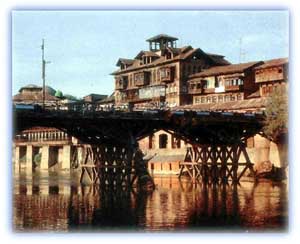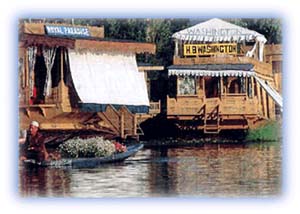Kashmir himalayas
General Info
· Dal and Nagin lakes
· Mughal Gardens
· Shankaracharya Hill
· Liddar Valley
· Pahalgam and Amarnath
· Photos of Amarnath trek
· Famous meadows
· Gulmarg
· Sonmarg
Arts and Crafts
· Carpets and Shawls
· Miniature Paintings
People
· Legends
History

![]()
| The Lakes and waterways of Kashmir One of the sources of the Jhelum river is the enchanting springat Vernag in the southeast of the Valley. The Mughal emperorJahangir built a garden around it. At the upper end, beyond theavenues of chinar lies a deep pool of water and from this origin,the river cuts a winding course from the southeast to northwest.Jhelum is navigable for almost 160 km (100 miles), from Anantnagin the east, past the saffron fields of Pampore, flowing throughthe heart of Srinagar, draining into the Wular Lake and fromthere onto Baramula in the west. |
 |
| One of many bridges over the Jhelum in Srinagar Credit: KOA |
The houseboat was the British answer to the edict of a Dograruler that no alien could buy immovable property in Kashmir.Built of seasoned cedar, the early houseboats were small andhighly mobile. They would escape the heat of mid-summer Srinagarby being towed down river to the Wular Lake. Here, under theshade of chinars, fishing for the 'mahseer', 'choose' and 'chos'started in mid-June.
 |
| Houseboats on the Dal lake Credit: KOA |
All rights reserved